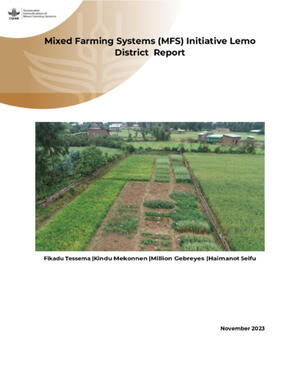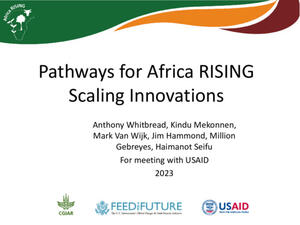
Trade-offs in sustainable intensification of smallholder livestock systems: Balancing benefits for farmers and stakeholders

Improved food and nutritional security from better utilisation of dairy cattle breed-types types in Senegal. (photo credit: ILRI/Karen Marshall)
A new study exploring how to achieve trade-offs—the balance of factors which may otherwise not be attainable at the same time—in livestock intensification calls for stakeholders to have an open mind to stakeholder perspectives.
According to the study, the attainment of a common ground is realized by recognizing the diverging views of stakeholders and the basics of decision-making in complex systems. This way of thinking ought to be a part of everyday practice, rather than an add-on or after-thought by the stakeholders involved in decision making on sustainable intensification interventions.
Understanding trade-offs from this point of view is significant where livestock production fulfils several objectives which cannot be fully achieved simultaneously. Such objectives may include the need to produce food for home consumption and the need to obtain income from sale of the livestock products.
The study looked at how trade-offs for livestock development are likely to affect decision-making in farms and households, which is where most decisions on intensification are taken. It focused on trade-offs whose decision-making has ramifications on smallholder profit improvements, environmental gains, gender equity, human nutrition and food security, food safety and zoonotic diseases; cultural acceptance and multifunctional livestock values as well as risks in livestock production in low- and middle-income countries.
Livestock production systems in many of these countries are developing towards more intensive practices in response to a growing demand for livestock products. Even so, when assessing the benefits of various intensification pathways, awareness and understanding of trade-offs by stakeholders is essential and contributes to efficient decision-making.

Improved food and nutritional security from better utilisation of dairy cattle breed-types types in Senegal. (photo credit: ILRI/Karen Marshall)
One of the main incentives for small-scale livestock producers to move towards more intensified systems is to achieve higher income or to reduce risk, especially where land or labour are scarce.
This means that producers are increasingly needing to make complex decisions that are determined by factors such as income, assets, social symbols, the needs of other stakeholders and the agricultural development sector in general.
The research shares findings from a (partial) trade-off analysis on the household level of dairy cattle enterprises in Senegal which compared different levels of intensification, such as choice of livestock breed and management input.
The study was conducted by researchers from the International Livestock Research Institute (ILRI), the International Institute of Tropical Agriculture (IITA) and the Supporting Evidence Based Interventions project at the University of Edinburgh.
Download the full paper which is authored by Gareth Salmon, Nils Teufel, Isabelle Baltenweck, Mark van Wijk, Lieven Claessens, Karen Marshall.
Edited by Paul Karaimu.















